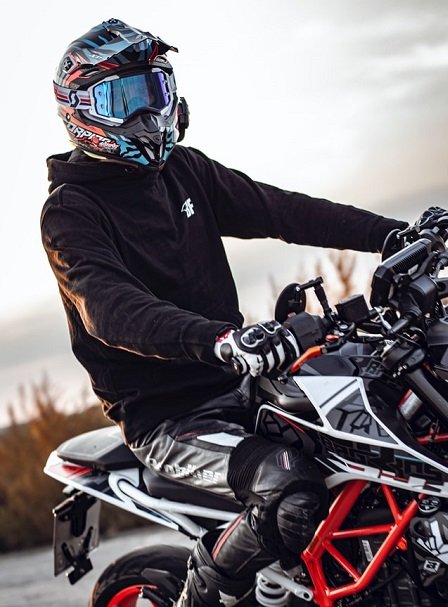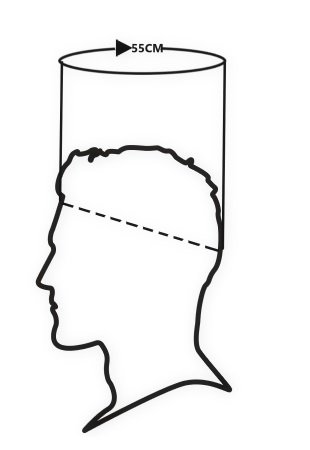Motorcycle Helmet Measurement Guide
Updated on | By Mohit Chauhan

By wearing a motorcycle helmet, motorcyclists do their bit to ensure maximum safety. After all, in the event of an accident, it is the helmet that protects one’s head from potentially life-threatening injuries.
However, proper fitting is the ‘nuts and bolts’ of an ideal motorcycle helmet. An oversized helmet can slip out of position, which is annoying, while simultaneously increasing the risk of injury in the event of a fall. Likewise, a helmet that is undersized creates pressure points and may even cause discomfort on long tours. Either of the cases, a bad sized helmet drastically reduces your sense of well-being, your enjoyment of riding, and your ability to concentrate.
In today’s blog, we will discuss everything related to fitting and measurement that is required to shortlist an ideal motorcycle helmet. So keep on reading further to get an in-depth understanding before you plan to purchase your first beginner helmet.
Why is it important to buy a helmet that fits?
Fundamentally, whether it is a full face, modular or open face, a helmet is designed to protect the head from accident-related injuries and is the most important piece of protective gear a rider should have.
A poorly sized helmet is likely to compromise the safety of the rider. If the helmet is too large on the head, it may pop out during an accident and not provide the necessary protection.
On the other hand, a helmet that is too small is likely to create discomfort and inconvenience while riding.
To ensure both safety and driving comfort, it is imperative that the helmet be precisely adapted to the head’s anatomy. Thus, a good helmet should be neither too big nor too tight.
Fitting of a motorcycle helmet
The circumference of the forehead is an ideal reference point for the correct helmet size – in fact, the size of the helmet should be the same as the circumference of the forehead. Since helmet sizes and fits sometimes vary even within the same brand, a thorough trial is must.
Riders with weak sight will of course have to wear prescription glasses while riding, same applies to wearers of balaclavas and/or earplugs, so the helmet should be able to accommodate additional accessories if need be.
There are typically two or three shell sizes for each helmet variant; manufacturers use padding of varying thicknesses to achieve up to eight standard sizes between XXS and 3XL, or 51/52 and 65/66. In case the padding is too thick, the helmet tends to become loose after prolonged usage. This is especially the case in medium sizes with models that are produced in only two shell sizes. Such models in particular should be left on the head for at least 30 minutes during testing.
If you are wearing a helmet that is too tight, you may feel pressure points (hot spots) on your forehead all the time. While this is unpleasant, it can also be dangerous if your focus is impaired while riding.
A helmet is too small if:
- It creates pressure points or causes discomfort.
- The chin strap closes with a lot of effort.
- The shell of the helmet significantly reduces the field of vision from all sides.
However, a helmet that just feels right initially does have a tendency of expanding after some time. This is because the inner padding adapts more and more to the shape of your head when worn frequently. Thus, it’s better to buy a helmet that’s a little tight than the one that’s perfectly fitting, but if you’re constantly experiencing discomfort while wearing it, you obviously won’t be able to use it.
Note: If only the side parts of your helmet press towards your head, it’s not quite as bad as you may think, since this will not create any significant headaches.
If your motorcycle helmet is too big, you can immediately feel it. The helmet fits loose and you can turn it back and forth very easily. While riding at high speed, you almost feel like the helmet is lifting off. But the worst part is; in case the helmet doesn’t fit your head, the impact from the crash will not be absorbed by your helmet causing serious injuries to your head.
A helmet is too big if:
- It is possible to fit two fingers between the head and the helmet around the forehead.
- It is possible to rotate the head while the helmet is held in place.
- It is possible to pull it off the head with the chin strap closed.
If you have already purchased a helmet that is too big, you may still be able to adjust the fit. There are some manufacturers that offer additional cheek pads that allow you to increase the size of the helmet’s lining. Or, you can wear a cap or hood under the helmet. Many motorcycle riders like to wear a comforter in order to protect their hair; this can additionally improve the fitting on a loose helmet.

Following tips will help you determine if the helmet fits properly
- The helmet should fit snugly around your head (like a baseball cap). Movement of the helmet to the right or left should not be possible.
- However, pressure points should not be felt. Each person has their own unique head shape and each helmet model has its own fit. Thus, not every helmet model may fit every head.
- The cheek pad should be positioned between the cheekbone and the jawbone. These cheek pads are usually tight-fitting, chewing gum might not be possible. The tight fit of the cheek pad is necessary because it allows the helmet to provide stable lateral support, for example, when looking over the shoulder. However, they tend to settle over time.
- The chin strap serves as an anti-skid protector and when closed, it should not be possible to slide it over the chin.
- Be aware that due to the large number of different helmet models and correspondingly many different fits, there can be variations between your existing helmet sizes.
Determining the correct helmet size
When it comes to helmets, the circumference of the head serves as the ultimate benchmark. You can determine the helmet size using a measuring tape.

Hold the measuring tape around your head. Do not let it slip around the back of your neck, but instead run it along your head, over your ears and approximately a thumb’s width above your eyebrows. At this point, take a glance at the measurement.
In case you don’t have a measuring tape at hand, just take a normal string and use it like a measuring tape. Just remember the points and re-measure them with a ruler.
Note: If the measurement is between two sizes, it is always recommended to choose the smaller size (provided the smaller size does not create pressure points).
| Size | Head Circumference (CM) |
|---|---|
| XXS | 51-52 |
| XS | 53-54 |
| S | 55-56 |
| M | 57-58 |
| L | 59-60 |
| XL | 61-62 |
| 2XL | 63-64 |
| 3XL | 65-66 |
After you have found the ideal helmet basis your head circumference, it is important to test it carefully.
Here are some important pointers that will make it easier for you to test your helmet once you have calculated your head circumference.
- Your helmet should always stay straight and not slip too far down your neck.
- If you notice wrinkles on your forehead when you move the helmet back and forth, this indicates that the helmet has a tight fit.
- Only the padding of the helmet should touch your scalp to prevent unwanted pressure points.
- The helmet must not swing while shaking your head; however, it should not be too tight either.
- The straps of the helmet should loop under the ear and the closure should not press against the neck
- The straps of the helmet should be tightened so that the helmet can hardly move. The chin pad should rest against the chin.
- Glass wearers can also find the right helmet: Initially, the glasses should not be taken into account when measuring the circumference of the head. Instead, you should follow the same procedure as described above. Once you have shortlisted your helmet, try it on with your glasses and make sure there is enough room. The only important thing is that it should sit correctly and there should not be any pressure points around the glasses.

Determining motorcycle helmet size in children
Determining helmet size for children works in the same way as for adults; you can figure out the circumference of the head by placing a measuring tape or a string around the head above the eyebrows and ears over the forehead.
Just like adults, the sizes of motorcycle helmet do not change for children. So, you can refer to the size chart shared above to calculate the accurate helmet size for your kid. However, what is important to remember here is that the little ones quickly outgrow their original size and therefore, the helmet size should be checked regularly among children. This will ensure that it does not become too small and that your child always wears a comfortable motorcycle helmet that offers maximum protection.
How to tell if it's the right sized helmet
- You experience no pain around the forehead as you wear it.
- The fit of the helmet is not very comfortable, and you feel it is slightly tight. This is perfectly normal, as the protective padding will settle down with time to adapt to the shape of your head.
- When the strap is closed, the helmet provides a proper fit, does not interfere with head movement and does not extend to the eyebrows.
- No portion of the helmet obstructs your field of vision.
- You can feel a slight pressure from the protective padding on the top of your head and around the cheeks, thereby ensuring that there are no gaps between your head and the inside of the helmet.
Advice: Under no circumstances should you determine the size of your helmet by wearing an old helmet or the one that you have borrowed from someone else.
The inner padding of the helmet ends up taking the exact same shape of the head of the first user. So, even if you find it comfortable, be aware that it will be less effective in an impact.
Excessive use of the helmet can reduce its effectiveness and shorten its lifespan. This will cause the protective paddings to compress, which will widen the inside area of the helmet.
What to do if your motorcycle helmet is tight?
So in the event that your helmet is too tight, we have some good news: it is not absolutely necessary to buy a brand new one. In fact, several measures can be adopted to enlarge the helmet and adapt it perfectly to your head size.
Loosening your helmet around the ears
An excessively tight helmet will instantly press against your ears, causing them to swell and become achy.
The inner paddings of modern day helmets are completely removable. These are made of special foam to better adapt to the shape of the head, and can be pulled out and adjusted to accommodate the shape of the ears using a cutter.
In case this solution doesn’t work as expected, you can use a filer to grind the inner shell which is generally made of Styrofoam, in order to widen the space and enlarge the size of the ear chamber.
Loosening your helmet around the cheeks
Normally, helmets are marketed with a standard size of cheek pads that will adjust perfectly with the size of the outer shell. Still, majority of manufacturers provide different sized cheek pads for any given helmet size. It is best to check the brochure for a list of those available for the particular helmet model and purchase the cheek pad that best fits the shape of your face.
Loosening your helmet around the forehead
Sometimes a helmet that is too tight, if worn even for a short time, may leave evident marks on the forehead that normally fades away within few minutes. If this problem does not cause any pain, it is not recommended to operate on the helmet. But, should it cause any discomfort, you can work on the inner padding in the same manner as we discussed for the ears.
Headache due to tight helmet
A tight helmet squeezes the head and inevitably leads to headache and neck pain. Widening the inner shell or shaping the padding, is the most effective solution to eliminate head and neck pain. You can use a small jar to increase the width of the helmet, or you can insert a deflated ball and increase its air pressure gently which causes your helmet to widen a bit. This operation must be performed very carefully, or you might end up with a very loose helmet.
What to do if your motorcycle helmet is loose?
One can easily overcome the problem of a slightly loose helmet by wearing a balaclava.
The balaclava has several benefits: first of all it solves our problem by increasing the thickness of the head, while simultaneously allowing the scalp to breathe which prevents sweat from settling on the padding of the helmet.
However, if wearing a balaclava does not solve the problem, it is recommended to check the padding for any kind of deterioration. In case of an old helmet, it is highly likely that the padding has worn out and may need replacement. This can be purchased from any reputed motorcycle helmet store near you.
But in case balaclava and thick padding does not solve the problem, it is best to purchase a new helmet by measuring your head circumference once again. Remember that a helmet with an unbalanced fitting can unload the force of impact in an uneven manner over your head.
Tips for buying a right sized helmet
- To determine the correct helmet size, measure the circumference of your head around your forehead, above your ears and at the back of your head. It is best if someone can do this for you. Also make sure that you take this reading several times to be extra sure of your helmet size.
- Ensure you reserve sufficient time when buying your helmet.
- Choose retailers that offer as many brands of helmets as possible. Doing so increases the possibility of finding a compatible helmet quickly.
- The helmet must fit securely over the entire head without pressing against it. The right fit can be determined by the fact that the skin of your forehead shifts when you turn the helmet.
- After prolonged usage, the interior eases a bit. So do not choose a helmet that is big.
- When in doubt about whether the helmet is of optimal size, we recommend that you try to wear the same helmet model in a smaller size. If the helmet presses unbearably, you will know that you have chosen a smaller size.
- While ordering, ask your dealer about customizing the interior of the helmet. For example, some helmet brands offer adjustable cheek pads to accommodate your face cut.
- With a closed and correctly adjusted chin strap, it must not be possible to pull your helmet out of your head, even with a great deal of force. Furthermore, the chinstrap should not rest on the Adam’s apple and the buckle should not press against the lower jawbone.
- When it comes to riders with particularly large head, we recommend choosing renowned brands like HJC that offer models in sizes up to 4XL (which is equivalent to a head size of 67 to 68 cm).
- Try wearing the helmet in the store for at least 30 minutes. This time period is sufficient to recognize possible pressure points and a possible discomfort from the padding (if possible, take a test ride).
- And lastly, always make sure that the inner padding is removable.




